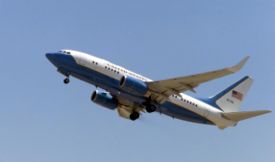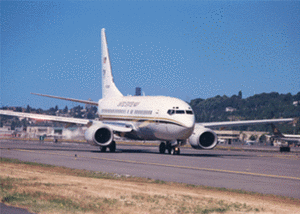PlaneSpottingWorld welcomes all new members! Please gives your ideas at the Terminal.
C-40 Clipper
| Boeing C-40 Clipper | |
|---|---|
| A C-40B VIP transport taking off. This kind of aircraft occasionally serves as Air Force Two. | |
| Type | Military transport aircraft |
| Manufacturer | Boeing |
| Introduced | 2001-04-21 |
| Status | Active service |
| Primary users | U.S. Naval Reserve United States Air Force |
| Produced | 2001-present |
| Number built | 12 |
| Unit cost | US$70,000,000 |
| Developed from | Boeing 737 |
| Variants | Boeing Business Jet |
The C-40 Clipper is a military version of the Boeing 737 airline transport. It is used by both the United States Navy and the United States Air Force.
Contents
Variants
C-40A
The C-40A Clipper provides critical logistics support to the United States Navy. Its flight deck features a flight management computer system with an integrated GPS. The C-40A is compatible with future GATM/FANS operating environment (RNP-1). It is RVSM capable. It has the Traffic Alert and Collision Avoidance System II on board. It also has an enhanced ground proximity warning system, predictive wind shear, head-up display and TACAN/UHF/IFF functions.
The U.S. Naval Reserve, which operates and maintains the aircraft, is the first customer for the newest member of the Boeing Next-Generation 737 family.[1] The Clipper was ordered by the Navy to replace its fleet of aging C-9B Skytrain IIs. The C-40A is the first new logistics aircraft in 17 years to join the Naval Reserve. Currently, the Naval Reserve provides 100 percent of the Navy's worldwide in-theater medium and heavy airlift.
The Clipper meets or exceeds international noise and environmental requirements that plague the current fleet of Naval Reserve C-9s. It is also more fuel-efficient and offers increased range and payload capabilities.
The 737-700C aircraft is certified to operate in an all-passenger (121 passengers), all-cargo or combination ("combi") configuration that will accommodate up to three cargo pallets and 70 passengers on the main deck.
The Navy purchased the airplanes using standard commercial practices, and ordered six of the 737-700C models. The first two of four aircraft were delivered on April 21, 2001 to Logistics Support Squadron Fifty Nine (VR-59) at the Naval Air Station/Joint Reserve Base Fort Worth, Texas. The remainder later in the year. The fifth and sixth aircraft were delivered in August 2002 to VR-58 at the Naval Air Station Jacksonville, Florida. A seventh one was acquired on November 22, 2004[2], the eighth was in February 2005[3], and the ninth was on May 25, 2006[4].
C-40B and C-40C
The United States Air Force selected the C-40B, a military version of the Boeing 737-700 Boeing Business Jet, to replace the aging fleet of C-137 aircraft for U.S. combatant commanders. The Air Force awarded the medium lift contract in August 2000. By using commercial off-the-shelf acquisition practices and a new lease program for the C-40C model, the Air Force reached a benchmark for aircraft procurement. The C-40C was the first military aircraft to be acquired in this manner. The 201st Airlift Squadron, Washington, D.C. Air National Guard, acquired two C-40C aircraft in October 2002. The C-40C is intended to replace the aging C-22. The 89th Airlift Wing acquired its first C-40B aircraft in December 2002. Both units are based at Andrews Air Force Base, Maryland. The 15th Airlift Wing, Hickam AFB, Hawaii, acquired its C-40B for U.S. Pacific Command in February 2003.
The cabin area is equipped with a crew rest area, distinguished visitor compartment with sleep accommodations, two galleys and business class seating with worktables.
The C-40B is designed to be an "office in the sky" for senior military and government leaders. Communications are paramount aboard the C-40B which provides broadband data/video transmit and receive capability as well as clear and secure voice and data communication. It gives combatant commanders the ability to conduct business anywhere around the world using on-board Internet and local area network connections, improved telephones, satellites, television monitors, and facsimile and copy machines. The C-40B also has a computer-based passenger data system.
Specifications (C-40A)
General characteristics
- Crew: 4
- Capacity: 121 passengers
- Payload: 40,000 lb (18,000 kg)
- Length: 110 ft 4 in (33.63 m)
- Wingspan: 112 ft 7 in (34.32 m)
- Height: 41 ft 2 in (12.55 m)
- Wing area: ft² (m²)
- Empty weight: 126,000 lb (57,150 kg)
- Loaded weight: 134,000 lb (61,000 kg)
- Max takeoff weight: 171,000 lb (78,000 kg)
- Powerplant: 2× CFM International CFM56-7 SLST turbofans, 27,300 lbf (121 kN) each
Performance
- Maximum speed: 534 knots (615 mph, 990 km/h)
- Range: 3,000 nm (3,500 mi, 5,600 km)
- Service ceiling: 41,000 ft (12,500 m)
- Thrust/weight: 0.407
External links
- C-40 page on Boeing.com - retrieved 20 December 2006
- C-40B/C US Air Force fact sheet
- C-40A Naval History page - retrieved 20 December 2006
- "Clippers Hitting Their Stride Despite Past Controversy" article on DefenseIndustryDaily.com - retrieved 20 December 2006
- "Aircraft Changes Save Navy Millions" article on military.com
- C-40 Detailed overview on GlobalSecurity.com
Related content
Related development
Designation sequence
Related lists
- List of active United States military aircraft
- List of military aircraft of the United States
- List of military transport aircraft
Lists relating to aviation | |
|---|---|
| General | Timeline of aviation · Aircraft · Aircraft manufacturers · Aircraft engines · Aircraft engine manufacturers · Airports · Airlines |
| Military | Air forces · Aircraft weapons · Missiles · Unmanned aerial vehicles (UAVs) · Experimental aircraft |
| Notable incidents and accidents | Military aviation · Airliners · General aviation · Famous aviation-related deaths |
| Records | Flight airspeed record · Flight distance record · Flight altitude record · Flight endurance record · Most produced aircraft |


